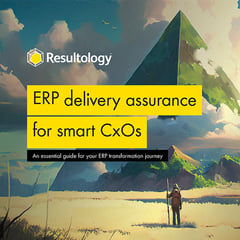We decided to attend UKISUG Connect early in 2018.
Like any conference, we put our detailed plans to the back of our mind for a while once we’d confirmed the booking - making a mental note to pick up the topic early April.
When we looked at the available stand packages, most of the decent spots had already gone.
We were either left with booths facing outwards on the periphery or super expensive shell-scheme options which we didn’t feel would be a great investment.
Instead, we opted for a Bronze package close to the entrance / exit where we’d take our own stand. That way, we could re-use the stand for other events and invest in something that could be re-used - it was essentially a case of ‘do we pay to rent space or do we invest in creating one?’
Having held an interim Chief Marketing Officer role in the past, I’d done quite a few conferences in the SAP ecosystem - TechEd and Sapphire mainly. During my time as CMO with Basis Technologies, I initiated an event attitude of ‘owning the show’.
We hired a racing simulator, built our own branded track, threw up a Top Gear leaderboard and then waited for egos and hubris to play their part. The finishing flourish at one TechEd event was to stick visitor lap times on their lanyards - turning attendees into walking Ad boards for our stand.
It worked well. Very well.
Exhibitions are about getting people on to your stand. There’s nothing worse than seeing a couple of disinterested people trying to woo weary visitors over with A5 leaflets and the promise of a free demo.
For UKISUG Connect we’d already committed to doing a couple of live workshop research sessions. Building on our research-backed SAP Success Report and Derek Prior’s Gartner pedigree - we figured that live research would be better than talking at people.
Derek was booked in to run an interactive research workshop on Successful S/4 Programmes. Nick Coburn would run a live research session on SAP Vendor Selection based on his vast experience working both vendor and client-side in the SAP world.
So, when it came to designing our UKISUG Connect presence, research was already at the forefront of my mind.
What’s the opposite of Agnostic?
One of the problems with industries like SAP is that people don’t tend to look at alternatives - they become technology ‘gnostic’ - they view the world of technology through whatever vendor-tinted spectacles they grew up wearing.
If the only tool you have is a hammer, you tend to see every problem as a nail - Abraham Maslow
I like to spend time in the shadows - exploring dark spaces that Enterprise tech people either ignore or fail to see. Around April this year I was exploring a couple of these dark spaces.
The first was Graph Databases. Having re-acquainted myself with a former colleague who’s since become an AI expert (we've subsequently hired him into the business) I’d become deeply immersed in some cool multi-model open source database technology that had flipped my whole understanding of databases on it’s head - so much so that my brain hurt.
The second was Game Development. Having kicked off a local initiative to promote emerging digital business in my home town, I’d met a team who’d developed a prototype game and was looking for funding. I’d spent time with their owner helping him with his business plan and exploring ways to kick-start his game studio. In the end, he decided to put his plans on ice and temporarily shelve his concept but it was an interesting rabbit hole.
When I get an idea it crystalises really quickly. Too fast for me to articulate it fully for fear of confusing people - meaning that I have to break it into chunks to first get understanding and then get buy-in. I've got much better at this as I've matured.
So, in our UKISUG Connect planning meeting when I casually said...
I expected nothing less than rolling eyes and sighs.
Most people would be happy building a nice Survey Monkey research questionnaire and sharing the results. The team knows that this isn't my thing.
Go Big or Go Home
First of all, we’d build a 3D space station. Then, we’d enable people to interact with objects in the space station to answer questions. The questions would be served to them via a real-time API call to a Graph Database. This would both serve persona specific questions - so different people would get tailored content - and record their responses in real-time so that the API could provide aggregate results.
.png?width=795&name=sap%20virtual%20reality%20worlf%20graph%20database%20(1).png)
We’d build the interface VR using the latest HTC Vive headset.
Then, we’d get Derek Prior to be our AI guide - like a quintessentially British Hal.
If we only have a 3x3 metre stand, what better way to get a bigger space than creating a virtual world?
Plus, we could model Hall 3 of ICC in Birmingham - the actual room that people would be in as they were in the VR Research Centre. A nice meta-touch that would flip people out.
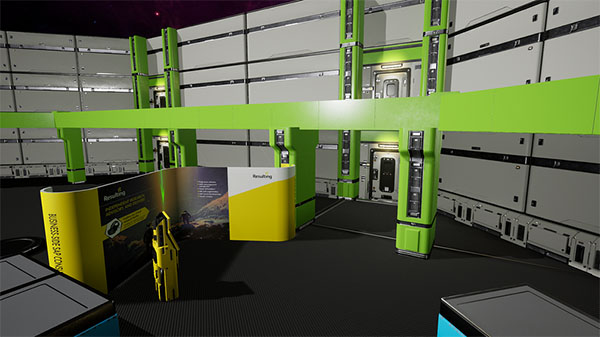
And, don’t forget, there was also the small matter of designing a research questionnaire that was interesting, pertinent and could be flexed to suit the 4 different personas of visitors we were likely to encounter.
Between deciding to attend the event, starting to build a VR world and the event actually happening, I’d somehow let my partner convince me to go to Rwanda on a 2 week Autumn holiday. Her voice was a distant list of places I’d never heard for a week or two.
Next thing I knew, Tripit had automatically picked up the booking confirmations for the flights and AirBnB lodgings that Sophie had sent to me, meaning they’d started to appear in my calendar.
Bit of a problem Soph - seems that we’re in Rwanda when I’m meant to be at the UKISUG conference.
I won’t repeat her response. But she repeated it under her breath for 3 days as she changed all of our bookings individually.
Post amendments, we were due to land back 2 days before the conference, meaning that I had a 12 day blackout period between the 27th October and 8th November. I’m not a control freak, but I can be pretty intense when I have something important on my radar. The thought of planning going off-piste while I was away wasn’t a comfortable one.
So, I set an artificial finish date for the project on the 17th October. Lot of software projects do this - create false urgency. But developers often sense it and treat it as a false deadline.
To make things a bit more real , we booked our Quarterly company meeting for the 18th October with a full test of the VR Research Centre and exhibition stand at a farm in Derbyshire.
As you cans see from our Cumulative Flow Graph from our Agile toolset Favro, this strategy worked well.
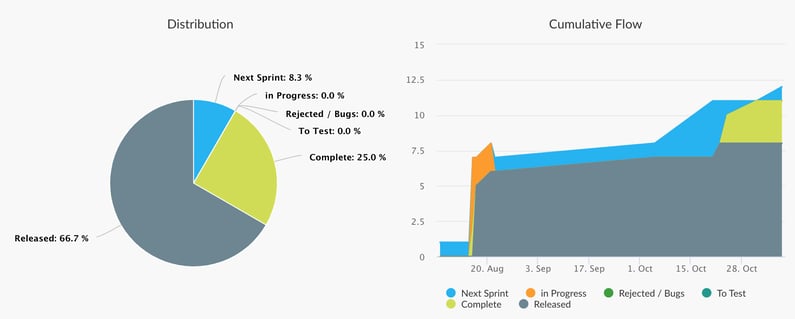 © Resulting Limited 2019
© Resulting Limited 2019
We’d already done a small dry run when we launched our STEM Studio at the end of October and noticed some minor niggles in ‘game play’. Given that we have a 2.5 days at the conference with 7 hours per day, we only have 17 hours to shuttle people through the VR Research Experience, if the cycle time per player is 10 minutes, we only get 100 respondents even if we’re 100% utilised.
So a major part of testing is actually refining the experience and removing the things that distract ‘players’ from the main purpose.
The gameplay involves interacting with various ‘devices’ around the Research Facility. Deciding where these are placed, marking them out (first with a glowing yellow halo, and later with a big green arrow) vastly improved the usability and efficiency of each ‘visit’.
Similarly, Nathan placed tramlines on the floor to guide the player around the facility.
Again, this shaved chunks of confusion off the gameplay.
I found it interesting - as a contrast to Enterprise Software - that testing was more about driving adoption and smoothing out the experience than finding bugs. There were bugs too - you could occasionally walk through a wall into deep space - but the focus of testing was on making the product better for the player and driving a slick experience.
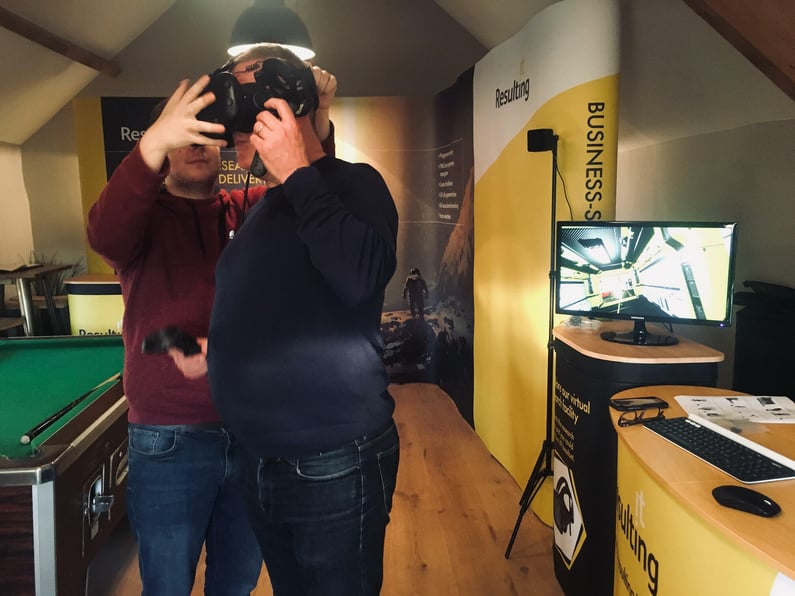
One area of focus was the navigation controls in the VR world. In addition to obvious head movements, the two controllers have a huge range of control options - for example if you squeeze the grips, your virtual hands clasp!
Amazing.
To navigate around the environment, there are 2 basic options. You can either teleport by throwing a disc with a connecting arc to the location you want to move to - essentially taking big grass-hopper leaps. Or, you can walk around using a trackpad on the thumb of the controller.
The latter is most realistic but also gave 50% of players motion sickness. The first time I tested in this mode I had a slight hangover and had to lie down for 30 minutes after ‘playing’.
Our Delivery Director, Sean Baber refused to ‘go back in’ after his early experience.
Part of the testing process, therefore, involved tweaking parameters around speed of movement, acceleration, and deceleration until the level of nausea reduced to be the exception.
The VR Headset can sense height. This means that your head height in-game is relative to your height in real life. If you sit on a chair, your in-game avatar is childlike. Giants like Nick Coburn have to duck to walk through doorways. Again, more refinement.
Another factor that’s very different to Enterprise Software development is the notion of creating a holistic experience. Early on, the experience was OK. But as more and more elements were added, it improved exponentially. Adding branding and lighting first made it feel more realistic.
Adding sound created a huge leap in experience. The ambient sounds and thematic music created a sense of ‘being there’. Then, when Derek spent an hour in our STEM studio to record scripted voice-overs and a few green-screen sequences, things went up another level.
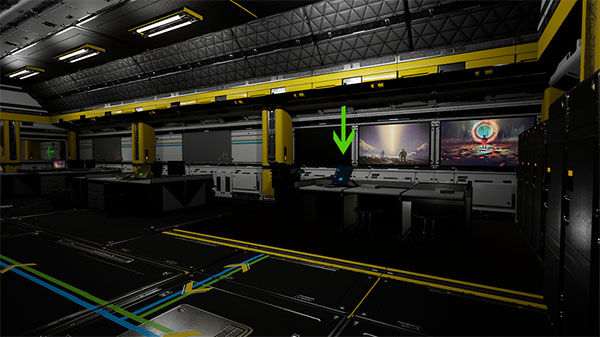
Because the player cycle time was important, Derek recorded a few hurry-up prompts that would be played if the current ‘researcher’ wasn’t moving through the space station quickly enough. In our testing, players really noticed this and it brought down the cycle time to sub 7 minutes for nearly every player (apart from Natalie who got distracted and lost).
One of the final integration steps was to display the aggregate research results in-game as part of the transitions between ‘rooms’ in the Virtual world. We’d designed this in from the start with connecting corridors and elevators that would both allow time for the next room to load into memory and serve to playback the current player’s results vs. other researchers on screens in the virtual world.
To do this, Greg had to build a couple of back-end APIs which Nathan would receive as JSON strings and render as pie charts in the world. This connectivity gives a nice closed-loop link between real-world player registration - as the game knows the player persona and serves you relevant questions once you enter your PIN number, individual player responses which are posted in real-time from the VR world based on interaction with virtual devices, and aggregated results which are compared to the player responses and then played back on screens in-game.
Nathan added a few final flourishes - an S/4 HANA Database that you can throw or kick around one of the rooms. And a full 3D rendering of our stand - right in Hall 3 where it’s likely to be in real life when you take the VR headset off.
Matthew at UKISUG suggested we relocate to the Innovation Area of the conference to showcase our technology - which means that hopefully more people will get chance to explore our alternate world.
On Friday, I had my final test of the VR Research Facility and I’m blown away by what the team has delivered in such a short time.
I’m also reminded of how important random innovation is.
In the past 3 weeks, I’ve had a couple of serious conversations with clients about how we can use elements of the same Open Source technology stack to solve their Enterprise software problems. I even spent some time with Forrester talking about the use of VR for Employee Experience and Research.
I'm also confident that we’ll be able to take elements of this project into our technology adoption consultancy work (what the SAP world calls Change Management and Training).
If you fancy a dose of reality on your SAP programme, you know where to find us.
And, if you're at UKISUG Connect, come say "Hi" and take part in our Virtual Reality Research experience.







